#southern white rhinoceros
Text

Southern white rhinoceros Ceratotherium simum simum
Observed by gigilaidler, CC BY-NC
#Ceratotherium simum simum#southern white rhinoceros#Rhinocerotidae#rhino#Africa#South Africa#KwaZulu-Natal
44 notes
·
View notes
Photo

[ Several captive Southern white rhinoceroses. ]
“John Hume, the owner of the world’s largest private rhino herd, is auctioning off his rhino farm, the starting bid being US$10 million. The question is, what are Hume’s rhinos really worth?
In recent weeks there have been quite a few emotional appeals from John Hume and his supporters to ‘see the value’ in what is being offered. I get that many people believe that this is John Hume’s life’s work, but the US$150 million the one-time billionaire reportedly spent on this enterprise is, in business terms, the project’s sunk cost. It is a business risk he chose to take, as he farmed rhinos with a view to selling the horn.
When he started, over a decade ago, the international sale of rhino horn was already banned and the domestic trade was banned in South Africa for a number of years until John Hume and Johan Kruger launched legal action, saying it is their constitutional right to sell rhino horn. Izak du Toit, the lawyer who represented the rhino owners to overturn the domestic trade ban, and who appears to be Hume’s legal representative in the current auction, said at the time, [If the domestic trade ban was overturned] “We would sell [rhino horn] to the poachers to prevent them from killing rhinos,”.
With all the effort to overturn rhino horn trade sanctions, both domestically and international, there was always an inherent risk in Hume’s strategy that the trade ban would remain, and he accepted this risk as legalising the trade in rhino horn was the only way to recuperate his investment. Hume has said that his 10-tonne of stockpile of rhino horns is negotiable as part of the current auction, adding that it is worth more than US$500 million on the black market. A curious message to give out.
The fact that there is still a ban on the international trade of rhino horn doesn’t change the lack of trying by Hume and other South African private rhino owners. Over the years they put forward models for a ‘regulated’, international legal trade in rhino horn. The business plans have loopholes big enough for a Mack truck to drive through and, in all this time, they have never invested in a consumer analysis. The pro-trade supporters have previously stated that, “What they [rhino horns] are used for is hardly relevant. The fact is that people are willing to pay.”. Even now, after more than a decade of pushing to legalise the international trade, the response to the FAQ page question, “Does anyone know what the demand for rhino horn is?” is, “There is no reliable data on the size of the market. The best way to determine the characteristics of a market is to engage in legal trade.”. Mmm, quite a risky approach if your goal is to save rhinos from poaching.
At least now they acknowledge that an international trade won’t stop rhino poaching, the response to the FAQ page question, “Doesn’t the market value ‘wild’ horn more than harvested?” is, “Possibly, yes. If there is a preference for ‘wild’ or whole horn, this will be reflected in the price buyers are willing to pay.”. A far cry from their earlier, evidence free, assertions that the supply from the privately owned rhinos in South Africa could satisfy demand in Viet Nam and China and that consumers would be willing to substitute farmed horn for horn from wild rhinos.
Legalising the trade in ivory for two massive one-off sales did not stop elephant poaching, it made it worse. There is every reason to believe the same would happen with rhino horn – as soon as you can legalise advertise you can create new demand; something else they have never been willing to factor into their pro-trade push. Further, those who can afford genuine rhino horn will pay for a ‘wild’ product. Consumers have been known to ask for the tail/ears of the rhino to be presented with the horn to show it was killed in the process and the horn didn’t come from a stockpile.
This rhino sale mess is a perfect demonstration of the misguided obsession with the commercialisation of wild species. John Hume and the other private rhino owners managed to overturn the ban on domestic trade in South Africa, but that did not create a market for a product nobody needs. Hume’s rhino horn auction in 2017 was a flop, as was his later attempt to launch a cryptocurrency backed by rhino horn.
John Hume’s 2,000 rhinos and his reported 10 tonne stockpile of rhino horn have zero commercial value as long as the international trade remains closed. Reinstating the South African domestic trade in rhino horn was seen a precursor to overturning the international trade ban, providing hope for the pro-trade rhino owners. The result was they were happy to devalue rhino horn from a poaching perspective but they have never wanted to devalue horn from a consumer perspective, as they didn’t want to undermine the potential for future profits.”
- Excerpt from “What Are John Hume’s Rhinos Really Worth?” by Lynn Johnson.
#Conservation#Poaching#Southern white rhinoceros#Southern white rhino#Mammal#NT#Article#Text#Photo#Live specimen#Captive#Upload
33 notes
·
View notes
Text
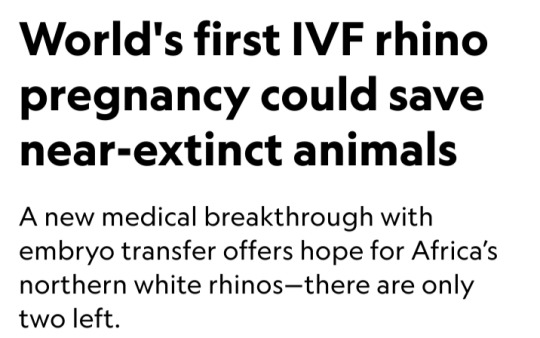

By Dina Fine Maron
January 24, 2024
Scientists have cleared a significant hurdle in the years-long effort to save Africa’s northern white rhinoceros from extinction with the first-ever rhino pregnancy using in vitro fertilization.
The lab-assisted pregnancy, which researchers will announce today, involved implanting a southern white rhino embryo in a surrogate mother named Curra.
The advance provides the essential “proof of concept” that this strategy could help other rhinos, says Jan Stejskal of the BioRescue project, the international group of scientists leading this research.
Curra died just a couple months into her 16-month pregnancy from an unrelated bacterial infection, Stejskal says.
However, the successful embryo transfer and early stages of pregnancy pave the way for next applying the technique to the critically endangered northern white rhino.
The process was documented exclusively by National Geographic for an upcoming Explorer special currently slated to air in 2025 on Nat Geo and Disney+.
BioRescue expects to soon implant a northern white rhino embryo into a southern white rhino surrogate mother.
The two subspecies are similar enough, according to the researchers, that the embryo will be likely to develop.
Eventually, this approach may also help other critically endangered rhinos, including the Asian Javan rhinoceros and the Sumatran rhinoceros, which each now number under 100 individuals, Stejskal says.
But the northern white rhino’s current situation is the most pressing by far.
There are no males left, and the only two remaining animals are both elderly females that live under armed guard on a reserve in a 700-acre enclosure in Kenya called Ol Pejeta Conservancy.
The boxy-jawed animals once roamed across central Africa, but in recent decades, their numbers have plummeted due to the overwhelming international demand for their horn, a substance used for unproved medicinal applications and carvings.
Made from the same substance as fingernails, rhino horn is in demand from all species, yet the northern white rhino has been particularly hard-hit.
"These rhinos look prehistoric, and they had survived for millions of years, but they couldn’t survive us,” says Ami Vitale, a National Geographic Explorer and photographer who has been documenting scientists’ efforts to help the animals since 2009.
“If there is some hope of recovery within the northern white rhino gene pool — even though it’s a substantially smaller sample of what there was — we haven’t lost them,” says conservation ecologist David Balfour, who chairs the International Union for the Conservation of Nature’s African rhino specialist group.
Blueprints for rhino babies
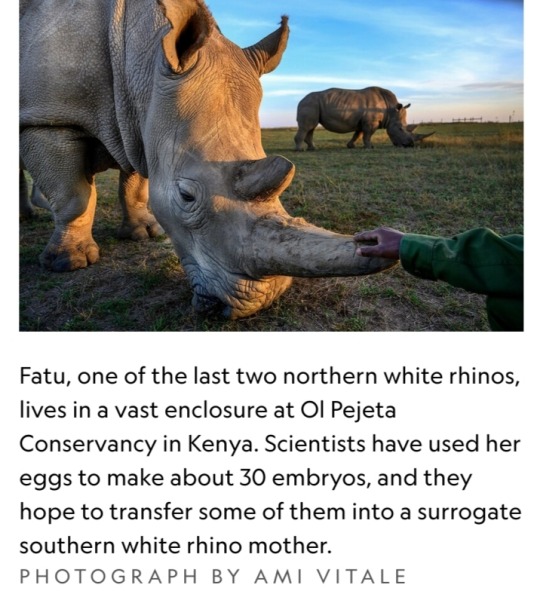
To stave off the animal’s disappearance, BioRescue has used preserved sperm from northern white rhinos and eggs removed from the younger of the two remaining females.
So far, they’ve created about 30 preserved embryos, says Thomas Hildebrandt, the head scientist of BioRescue and an expert in wildlife reproduction based at the Leibniz-Institute of Zoo and Wildlife Research in Berlin.
Eventually, the team plans to reintroduce northern white rhinos into the wild within their range countries.
“That’d be fantastic, but really, really far from now—decades from now,” says Stejskal.
Worldwide, there are five species of rhinoceros, and many are in trouble.
Across all of Africa, there are now only about 23,000 of the animals, and almost 17,000 of them are southern whites.
Then there are more than 6,000 black rhinos, which are slightly smaller animals whose three subspecies are critically endangered.
In Asia, beyond the critically endangered Javan and Sumatran rhinos, there’s also the greater one-horned rhino, whose numbers are increasing and currently are estimated to be around 2,000.
The BioRescue effort has experienced many setbacks, and even though the team now has frozen embryos, the clock is ticking.
The researchers intend to use southern white rhinos as surrogate moms for the northern white rhino embryos.
However, scientists want any northern white rhino calves to meet and learn from others of their kind, which means they need to be born before the two remaining females die.
“These animals learn behaviors — they don’t have them genetically hard-wired,” says Balfour, who’s not involved with the BioRescue work.
But birthing new animals in time will be a challenge.
“We’re really skating on the edge of what’s possible,” he says, “but it’s worth trying.”
Najin, the older female, will be 35 this year, and Fatu will be 24.
The animals, which were born in a zoo in the Czech Republic, are expected to live to about 40, says Stejskal, who also serves as director of international projects at the Safari Park Dvůr Králové, the zoo where the animals lived until they were brought to Kenya in 2009.
Impregnating a rhino
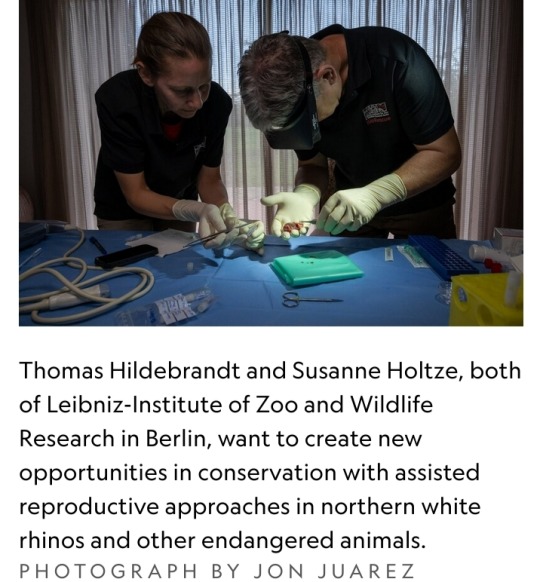
The next phase of BioRescue’s plan involves implanting one of their limited number of northern white rhino embryos into a southern white rhino surrogate mother — which the group plans to do within the next six months, Stejskal says.
They’ve identified the next surrogate mother and set up precautions to protect her from bacterial infections, including a new enclosure and protocols about disinfecting workers’ boots.
But now, they must wait until the female rhino is in estrus — the period when the animal is ready to mate — to implant the egg.
To identify that prime fertile time, they can’t readily perform regular ultrasounds at the conservancy as they might do in a zoo.
Instead, they have enlisted a rhino bull that has been sterilized to act as a “teaser” for the female, Hildebrandt says, adding that they must wait a few months to make sure that their recently sterilized male is truly free of residual sperm.
Once the animals are brought together, their couplings will alert conservancy staff that the timing is right for reproductive success.
The sex act is also important because it sets off an essential chain of events in the female’s body that boosts the chances of success when they surgically implant the embryo about a week later.
"There’s little chance the conservancy staff will miss the act. White rhinos typically mate for 90 minutes," Hildebrandt says.
What’s more, while mounted on the females, the males often use their temporary height to reach tasty plant snacks that are generally out of reach.
Boosting genetic diversity
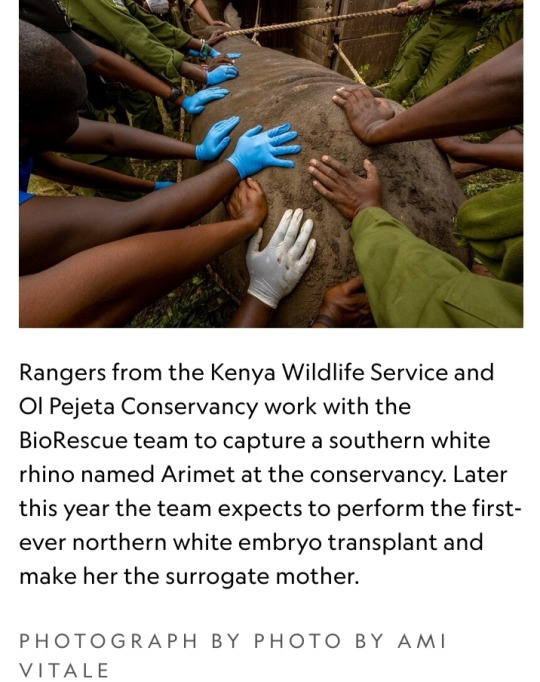
With so few northern white rhinos left, their genetic viability may seem uncertain.
But the BioRescue team points to southern white rhinos, whose numbers likely dropped to less than 100, and perhaps even as few as 20, due to hunting in the late 1800s.
Government protections and intense conservation strategies allowed them to bounce back, and now there are almost 17,000.
“They have sufficient diversity to cope with a wide range of conditions,” says Balfour.
Researchers don’t know exactly how many southern white rhinos existed a century ago, he says, but it’s clear that the animals came back from an incredibly low population count and that they now appear healthy.
Beyond their small collection of embryos, the BioRescue team hopes to expand the northern white rhino’s gene pool by drawing from an unconventional source — skin cells extracted from preserved tissue samples that are currently stored at zoos.
They aim to use stem cell techniques to reengineer those cells and develop them into sex cells, building off similar work in lab mice.
According to their plan, those lab-engineered sex cells would then be combined with natural sperm and eggs to make embryos, and from there, the embryos would be implanted into southern white rhino surrogate mothers.
Such stem cell reprogramming work has previously led to healthy offspring in lab mice, Hildebrandt says, but rhinos aren’t as well-studied and understood as mice, making this work significantly challenging.
A global effort
The northern white rhino revitalization venture has cost millions of dollars, supported by a range of public and private donors, including the German Federal Ministry of Education and Research.
Other partners on the effort include the Leibniz Institute for Zoo and Wildlife Research, the Czech Republic’s Safari Park, Kenya Wildlife Service, Ol Pejeta Conservancy, and also Katsuhiko Hayashi, a professor of genome biology at Osaka University in Japan who conducted the mouse stem cell research.
Building upon Hayashi’s stem cell techniques could ultimately bring the northern white rhino gene pool up to 12 animals — including eggs from eight females and the semen of four bulls, according to Stejskal.
An alternative approach to making more babies, like crossbreeding northern and southern white rhinos, would mean the resulting calves wouldn’t be genetically pure northern white rhinos, Hildebrandt notes.
The two subspecies look quite similar, but the northern version has subtle physical differences, including hairier ears and feet that are better suited to its swampy habitat.
The two animals also have different genes that may provide disease resiliency or other benefits, Hildebrandt says.
There are unknown potential differences in behavior and ecological impact when populating the area with southern white rhinos or cross-bred animals.
"The northern white rhino is on the brink of extinction really only due to human greed,” Stejskal says.
“We are in a situation where saving them is at our fingertips, so I think we have a responsibility to try.”
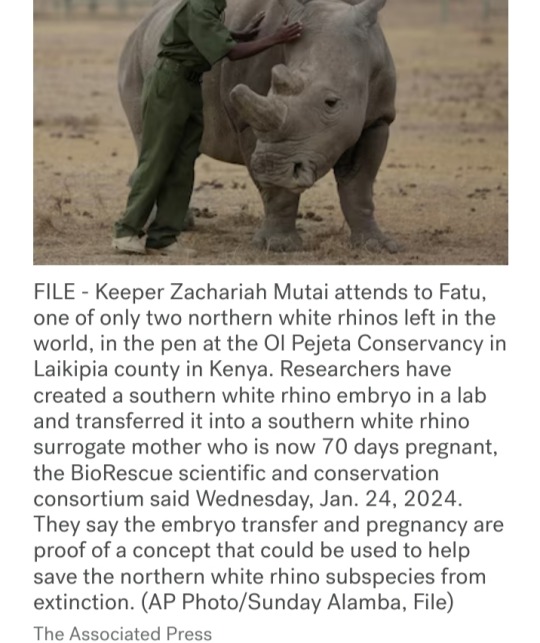
🩶🦏🩶
#northern white rhinoceros#rhino embryo transfer#in vitro fertilization#IVF#southern white rhinoceros#critically endangered animals#National Geographic#BioRescue#rhino horn#International Union for the Conservation of Nature#African rhino specialist group#Thomas Hildebrandt#German Federal Ministry of Education and Research#Leibniz Institute for Zoo and Wildlife Research#Kenya Wildlife Service#Ol Pejeta Conservancy#Katsuhiko Hayashi#genome biology#IVF rhino pregnancy
8 notes
·
View notes
Text
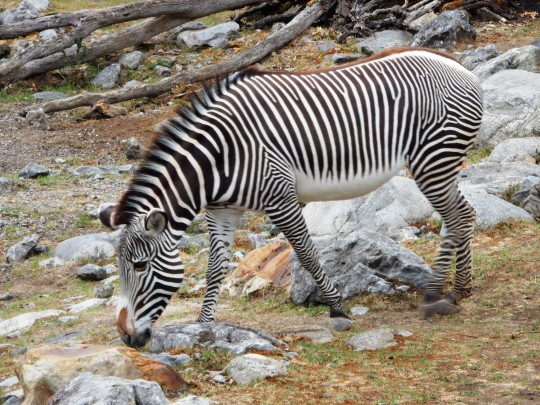











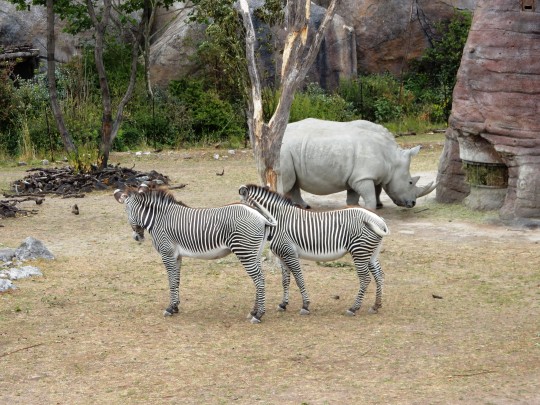

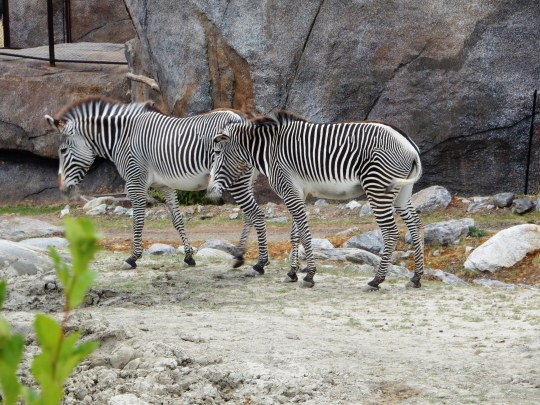




International Zebra Day
International Zebra Day is observed every year on January 31. With their natural environment diminishing and increasing human development, these gentle animals are in danger. When habitats are threatened, animals, too, become endangered. International Zebra Day is all about raising awareness and what you can do to help in the conservation of this animal. Zebras are mostly found on the African continent, in the semi-desert areas of Kenya and Ethiopia, and the hilly areas of Namibia, Angola, and South Africa. You can easily identify a zebra by its unique black and white stripes.
History of International Zebra Day
International Zebra Day was most likely founded by a consortium of conservation organizations such as the Smithsonian’s National Zoo and the Conservation Biology Institute. International Zebra Day aims to help raise awareness about the living conditions of zebras and how their numbers can be protected from further decline.
Presently, three types of zebra can be found in the wild. They are the Grévy’s zebra, plains zebra, and the mountain zebra. Although the Grévy’s zebra, found in the northern regions of Kenya and are extremely rare, they are an endangered variety having suffered a loss of more than 54% of its total population. The loss has occurred rapidly in the last three decades because of zebras being poached for their hides and pelts.
Zebras are found in the African Savannah where their natural habitat has been well preserved and not all zebras are in danger of disappearing. The other two subspecies of zebra are less endangered than the Grevy’s zebra. Plains zebras are thriving and don’t face threats of endangerment. The mountain zebra lives in South Africa, Angola, and Namibia. Along with the dangers of poaching, these zebras are also in danger from locals who might hunt them for meat when the going gets tough. Zebras have been battling many concerns regarding preserving their population.
International Zebra Day timeline
28,000 Years AgoZebras in Rock Art
They are depicted in cave rock art in African regions.
1261Zebras in Diplomacy
Zebras are sent as exotic gifts to establish democratic relationships.
1878The Quagga Becomes Extinct
Quaggas, a type of plain-dwelling zebra, become extinct.
2019Grevy’s Zebra is Endangered
It has a population of less than 2,000 mature zebras.
International Zebra Day FAQs
Why is International Zebra Day celebrated?
International Zebra Day is observed on January 31 every year to create awareness about the need to protect zebras.
How many zebras are left in the world?
They are considered endangered, according to National Geographic. There may be some 300,000 left in the wild, and on the Serengeti-Mara Plains, there are an estimated 150,000 plains zebras.
Are zebras endangered?
The Grevy’s zebra is considered endangered on the Red List of Threatened Species. Their population has gone down by about 54% over the past three decades, according to the African Wildlife Foundation.
How to Observe International Zebra Day
Dress up in its colors
Raise awareness
Donate
Celebrate International Zebra Day in style by dressing up in black and white. If you’re feeling adventurous, wear a zebra print outfit.
Talk about International Zebra Day on your social media accounts to raise awareness of this day. You can help spread information on their dwindling numbers, the dangers to their habitat, and what we can do to help.
The best way to observe International Zebra Day is by donating to organizations that ensure the welfare of zebras. You can donate to the World Wildlife Fund, Wildlife Conservation Society, and others.
5 Facts About Zebras That Will Blow Your Mind
They are fast runners
Zebra stripes are unique
Foals grow up quickly
They can sleep standing up
Zebras live in groups
Zebras can run at a speed of 40 miles per hour.
What fingerprints are to humans, stripes are to zebras.
Zebra foals can stand up as early as six minutes after they’ve been born.
However, they can sleep while lying down too.
A group of zebras is called a ‘dazzle.’
Why International Zebra Day is Important
Conserves the zebra population
Our chance to do something
Protects our future
International Zebra Day is aimed at conserving, persevering, and increasing the zebra population. But a large number of zebras isn’t enough. These celebrations ensure the animal’s well-being.
Celebrations like International Zebra Day allow us to do our bit for wildlife conservation. Through awareness programs and donation drives, we can become involved in the conservation of the species.
The planet is for all creatures to inhabit. International Zebra Day helps preserve the zebra population and envisions a future where all creatures can co-exist peacefully, without fighting for resources.
Source
#Grevyzebra#Zoo Zürich#Switzerland#spring 2023#Zurich#Southern white rhinoceros#Grévy's zebra#Lewa Savanne#outdoors#Bronx Zoo#Schweiz#USA#travel#vacation#day trip#summer 2018#original photography#spring 2017#animal#New York City#tourist attraction#flora#nature#fauna#International Zebra Day#InternationalZebraDay#31 January#meadow#tree
1 note
·
View note
Photo
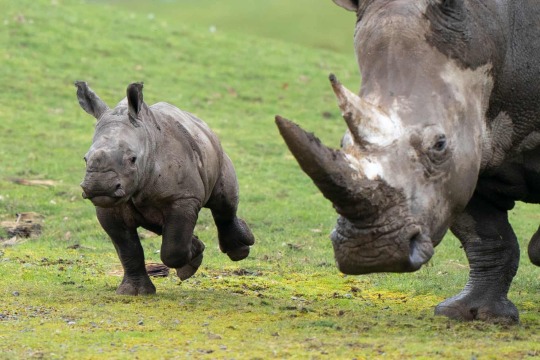
Lowestoft, England
A rare six-week-old southern white rhino calf explores her paddock for the first time at Africa Alive! in Lowestoft. The female rhino calf was born on Saturday 18 December as part of a European breeding programme.
Photograph: Joe Giddens/PA
#joe giddens#photographer#pa#lowestoft#england#southern white rhino#rhinoceros#africa alive#breeding programme#animal#nature#mammal
83 notes
·
View notes
Text
Global rhinoceros numbers have increased to 27,000 despite populations being ravaged by poaching and habitat loss, new figures show, with some species rebounding for the first time in a decade.
Rhinos numbered about 500,000 across Africa and Asia in the 20th century but their populations have been devastated. Last year, they began showing signs of recovery in some areas, although two species – the Javan and Sumatran – remain close to disappearing.
Figures released by the IUCN African Rhino Specialist Group, the conservation body, indicate that the global rhino population increased to about 27,000 at the end of last year, with southern white rhino numbers increasing for the first time since 2012, from 15,942 at the end of 2021 to 16,803. In 2021, the world’s rhino population was estimated to be 26,272.
Black rhinos, native to east and southern Africa, have been heavily depleted by poaching for their horns but last year increased by nearly 5%, rising from 6,195 at the end of 2021 to 6,487 at the end of 2022. This increase has happened despite a rise in black rhinos killed by poachers, and has been aided by conservationists establishing new populations that have grown in size.
Continue Reading
369 notes
·
View notes
Note
Do you think you could make a list from the strongest demon king to the weakest?
Maybe Wukong's sworn brothers other than the demon bull king wouldn't be included because we never see them fight (although I understand they fought alongside Wukong when he rebelled against heaven?)
I could only give out a rough outline since I'm not really a 'power scaler' and honestly it's hard to say if by strong you mean the most difficult or if they had powerful attacks. Most of Wukong's worst fights aren't, particularly because his enemies were physically powerful but just had a strong weapon or a single powerful attack while being a glass canon.
While Wukong's sworn brothers did join the fight against heaven, their own armies were captured. Not sure if this was to reflect Wukong's favoritism toward his own monkeys or to show how his sworn brothers were outclassed but I am not even going to try to guess.
So this will be more of a list of Wukong Most DIFFICULT fights to the easiest fights.
Hurt Wukong
Trapped Wukong
Fought (tie)
Fought (lost)
Lost without Fight
Never seen Fight (inconclusive)
Magic Item
Red Boy - made Wukong pass out, Guanyin subdued him, glass cannon
Scorpion Demoness - poisoned Wukong, killed by Pleiades Star Offical, glass cannon
Yellow Wind Demon - make Wukong blind, he needed Lingshan's help, glass cannon
Hundred-Eyed Demon Lord - blinded Wukong momentarily, also taken out by Star Official Pleides
Golden-Winged Great Peng - Talons overpowered Wukong, was taken out by Buddha
Silver Horned King - captured Wukong due to magic spell and has magic item, was killed later though
Single Horned Rhinoceros King - very powerful magic item used, subdued by Laozi
Yellow Brows Great King - powerful magic item and needed Maitreya Buddha help to defeat
Princess Iron Fan - blew Wukong away with magic item, he needed Lingshan's help
Golden Horned King - captured Wukong due to magic items
Six Eared Macaque - tie until Buddha gave Wukong the upper hand
Bull Demon King - impressive fight but still ran away after being overwhelmed in numbers
Yellow Robe Demon - impressive fight but Wukong still needed the 28 Star's help
Nine-Headed Insect - ran away until taken out by Erlang Shen
Black Wind King - good at escaping, needed Gaunyin's help
Great Immortal King of Spiritual Touch - Gaunyin defeated in the end
Yellow Toothed Elephant - defeated Bajie, lost to Wukong
Azure Lion / Lion-Lynx Demon - defeated Wujing, lost to Wukong
Grand Saint of Nine Spirits - Wukong had Tianzun to help
King of Dust Protection - captured Bajie and Wujing
King of Heat Protection - captured Bajie and Wujing
King of Cold Protection - captured Bajie and Wujing, was killed by Bajie
Lady Earth Flow - able to slip away, needed Nezha and King's Li's help
Great King Jupiter's Rival - had a magic item but never got a chance to use against Wukong
Tuolong Black River God - his own cousin took him out but even Wujing could fight him
Python Demon
White Bone Demon - hard to pin down but killed in one blow
Spider Demons - stole Sanzang but very easy to defeat
King of the Southern Hill
Tiger Strength Great Immortal
Elk Strength Great Immortal
Antelope Strength Immortal
White Deer Spirit
Nine-Tailed Vixen
Great King Fox Number Seven
Wansheng Dragon King
Demon King of Confusion
Dragon Demon King
Peng Demon King
Lion Demon King
Female Macaque King
Snub Nose Monkey King
Bear Mountain Lord
This is my personal take on the Demon Kings and as you can see, I did include demons that aren’t technically Demon Kings but rather the main antagonist in their arc. This also doesn't include ALL the demons or any gods or immortals that Wukong has fought with either, these are just the Demon Kings (or at least demons that are the big bad in their arcs) so there are still other antagonists that are in the book on here.
I am solely going on how the fights went in my notes and what I can remember so if you remember these fights going differently and actually want to add any details please let me know. I didn't include anything that the demons like 'claim' to have or powers or feats that they have done, just what they ACTAULLY did in the story, cause actions speak louder than words.
There could be grey area with the demons with magic items. And you could argue how easily the demons that caused Wukong the most damage were easily defeated by other gods just because they could bypass their one (1) magic spell gimic that was just giving Wukong trouble. Two of these Demon Kings were taken out by the SAME ROOSTER just because they are insect demons and roosters are their natural enemies. So take that as you will... Other demons Kings were defeated just cause their owner showed up before they could really fight too.
#anon ask#anonymous#anon#jttw#journey to the west#sun wukong#xiyouji#ask#Red Boy#Scorpion Demoness#Yellow Wind Demon#Hundred-Eyed Demon Lord#Golden-Winged Great Peng#Silver Horned King#Single Horned Rhinoceros King#Yellow Brows Great King#Princess Iron Fan#Golden Horned King#Six Eared Macaque -#Bull Demon King#Yellow Robe Demon#Nine-Headed Insect#Black Wind King#Great Immortal King of Spiritual Touch#Yellow Toothed Elephant#Azure Lion#Grand Saint of Nine Spirits#Lady Earth Flow#Great King Jupiter's Rival#Tuolong Black River God
33 notes
·
View notes
Text
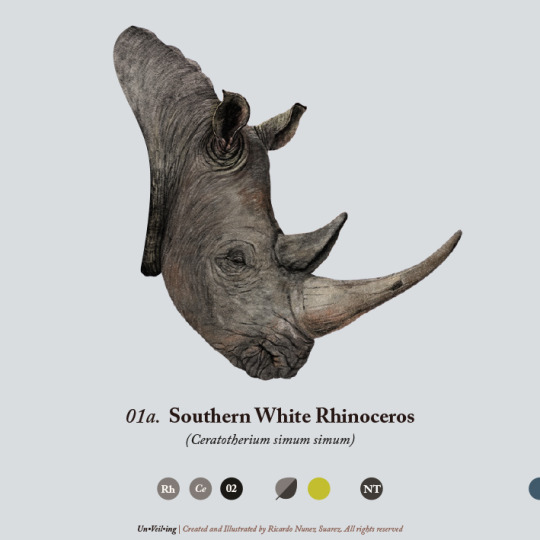
Southern White Rhinoceros
The name of the White Rhinoceros is attributed to a translation error. In Dutch, "white" is pronounced as "widj," which actually means "wide," referring to the rhino's mouth width. A more precise, albeit unused, name for this species is the square-lipped rhinoceros.
The White Rhinoceros is a genus comprising two subspecies. This is one of them. Wallpaper is available here.
#white rhinoceros#white rhino#rhino#rinoceronte blanco#rinoceronte#cute animals#love animals#wild animal#conservation#wallpaper#science side of tumblr#illustration scientifique#scientific illustration#illustration art#drawing animals#infographic
50 notes
·
View notes
Text

White rhinoceros (Ceratotherium simum)
These armoured beasts are the largest living rhinos. They’re found in dry African savannas, wallowing in the mud to cool themselves down. Today, they’re only found in Southern Africa. The story of the white rhinoceros is rather tragic- there are two subspecies, one northern and one southern. Both were overhunted in the 19th century, and the southern white rhino was reduced to less than 50 individuals by 1895. But it has made a grand comeback due to conservation efforts, today the most populous rhino species with more than 18,000 individuals in the wild alone. On the other hand, the northern white rhinoceros never recovered, and only two individuals are known to be alive today- both female. The only hope for this subspecies is if an unknown wild population remains, or if assisted reproduction technology can be used to create more males.
#markhors-menagerie#animal facts#animals#biology#fun facts#ungulates#odd toed ungulates#rhinoceros#white rhinoceros
6 notes
·
View notes
Text
Account of Central Tianzhu (LS54)
天竺, Middle Chinese *Then-trjuwk, Standard Chinese Tiānzhú, and 身毒, Middle Chinese *'Jwien-dowk, Standard Chinese Yuāndú, both derive from Iranian Hinduka and ultimately from Sanskrit Sindhu. As such these names have the same etymological origin as India.
師子, Middle Chinsee *Srij-tsi, Standard Chinese Shīzǐ, is the Sinhala kindom on Sri Lanka.
…
The state of Panpan, during Emperor Wen of Song's Yuanjia era [424 – 453] and Xiaowu's Xiaojian [454 – 456] and Daming [457 – 464] eras dispatched envoys with tribute to present.
…
The state of Gantuoli is located on an island in the Southern Sea. Their customs are roughly similar to Linyi and Funan. They produce ban班 cloth, jibei [tree cotton], and betel nut. The betel nuts are especially excellent, the pinnacle among the various states. During Xiaowu of Song's reign [454 – 464 AD], King Shipoluo Ranfuliantuo dispatched Senior Clerk Zhuliutuo to present gold, silver, and precious vessels.
…
The state of Central Tianzhu is located several thousand li south-east of Greater Yuezhi. The land is 30 000 li square. It is also named Yuandu. In the Han period Zhang Qian was sent to Daxia where he saw Qiong bamboo canes and Shu cloth. People of the state said they bought it in Yuandu. Yuandu is precisely Tianzhu. Probably the transmitted transcription of the sound and character are not similar, they really are the same. In the times of Han, they were controlled by and belonged to Yuezhi. Their customs and native characteristics are similar to the Yuezhi, but they are low-lying and humid, and feverishly hot. The people are weak and fearful in battle, and are weaker than the Yuezhi. The state is near a great river named Xintao which springs forth from Kulun and divided to become five rivers. Collectively they are called the Geng River [I.e. the Ganges]. Its water is sweet and pleasing. In it is true salt, coloured exactly white like water essence.
Native customs produce rhinoceros, elephant, marten, gerbil, hawksbill turtle, “fire blend” [huoqi火齊], gold, silver, iron, gold threads woven into complete gold felt, finely rubbed white folded [fabric?], excellent furs, and wool rugs. “Fire blend” is shaped like mica and is coloured like purple gold. It has a glowing sparkle. If divided up, it is thin like cicada wings. If piled up, it is like the layers of gauze or crepe. To their west they exchange and trade with Daqin and Anxi within the seas. There is much of Daqin's precious things – coral, amber, golden blue-green gems, pearls, gemstone-jade, tumeric, and storax. Storax is made by combining various fragrant saps and boiling them, it is not naturally from a single thing. It is also said that the people of Daqin gather storax, first press it for the sap to use as a fragrant ointment, and then sell its dregs to merchants from various states. Thus when it in turns come to the Central States, it is not very fragrant. Tumeric is only produced in the state of Jibin. The flowers are coloured exactly white and are delicate. It and those lotus flowers that are enclosed in the lotus leaves resemble each other. The people of the state first take it and send it up to the Buddhist temples, and for a number of days the fragrance wither, and then they clear away and remove it. Merchants seek out hirelings from within the temples, and so move it to sell to other states.
Emperor Huan of Han's 9th Year of Yanxi [166 AD], the King of Daqin, Antun, dispatched envoys to come and present from outside the frontiers of Rinan, during the Han period it was the only communication with them. The people of that state travel as merchants, from time to time arriving in Funan, Rinan, and Jiaozhi. Among the people from the various states on their southern frontiers there are few that have reached Daqin.
Sun Quan's 5th Year of Huanwu [226 AD], there was a merchant from Daqin, Ziqinlun, who came to Jiaozhi. The Grand Warden of Jiaozhi, Wu Miao sent him off to Quan. Quan asked about the region's native songs and customs. Lun provided detailed answers to the matters. At the time Zhuge Ke chastised Danyang, and captured short people from Yi and She [counties]. Lun saw them and said:
In Daqin [we] rarely see this [kind of] people.
Quan had men and women, ten each, and the selected envoy Liu Xian of Kuaiji sent off with Lun. Xian suffered a mishap on the road, and Lun then went straight back to his home state.
In the time of Emperor He of Han [r. 88 – 105 AD], Tianzhu several times dispatched envoys with tribute to present. Later the Western Region turned to rebellion and consequently they were cut off. Arriving at Emperor Huan's 2nd Year [159 AD] and 4th Year of Yanxi [161 AD], they frequently came from outside the frontiers of Rinan to present.
In the Wei and Jin periods, they were cut off and did not again communicate. However in the time of Wu, the King of Funan, Fan Zhan, dispatched a relative, Suwu, as envoy to their state. From Funan he issued forth from the mouth of the Juli, circled around a great bay in the sea, and straight north-west entered successive bays bordering several states. It could have been more than a year when he arrived at the mouth the Tianzhu river. He travelled against the water for 7 000 li and then arrived there. The King of Tianzhu was startled and said:
At the sea coast furthest away they still have this person.
He promptly shouted out orders to observe and take a look inside the state, and carried on selecting Chen and Song, two persons, with four Yuezhi horses as repayment to Zhan, and dispatched them to go back with Wu and others. After a total of four years exactly they arrived. At that time Wu dispatched Central Gentleman Kang Tai as envoy to Funan. When he saw Chen, Song, and others, he comprehensively asked about Tianzhu's native customs, as follows:
The Way of the Buddha is what fosters the state. The people are sincere and varied, and the land is fertile and well-watered. Their king is titled Maolun. The capital is a walled city. Water springs forth in a split flow, entwines it in a knot of channels [?], and flows down into the great river. Their palace halls all are engraved and patterned with inlays and carvings. There are bending streets, markets and residential compounds, buildings, storied houses and towers, bells, drums, tones and music, clothes, decorations and fragrant flowers. Communication flows by water and land, a hundred merchants exchange and gather, and there are strange playthings and precious jewels to indulge the heart's desires. To their left and right are Jiawei, Shewei, Yebo, and others, sixteen great states, their distance to Tianzhu is perhaps two or three thousand li. They all together respect and serve them, and consider them to be at the centre of Heaven and Earth.
…
The state of Shizi is a state nearby Tianzhu. Its land is harmonious and comfortable, there are no differences between winter and summer. The Five Grains follows from when people plant them, it is not necessary to follow the seasons. Their state in the past was without people, there was only ghosts, spirits and dragons who lived there. Merchant from various states came to trade and hold market together. The ghosts and spirits did not make visible their bodies, but only produced precious treasure and put forth what value they would be worth. The merchants who agreed to the price took them. People from various states heard about the pleasures of their lands. Following that, they contended to arrive there, and sometimes there were those who stopped to live there. Consequently they achieved a great state.
Beginning of Jin's Yixi era [405 – 418], they first dispatched to present a jade image, passing through ten years before arriving. The image was 4 chi, 2 cun tall [c. 97 cm], the jade's colour was pure and lustrous, and the shape and construction was unusual and unique. This image during the successive Jin and Song periods was located at Waguan Temple. The temple first had from before five images of the Buddha made by the hand of the summoned scholar Dai Andao [Dai Kui] and Gu Changkang's painted chart of the vimāna. People of the period spoke of them as the Three Unmatched. Reaching the reign of Donglun of Qi [r. 498 – 501], he consequently destroyed the jade image. First he cut off the arms, then he took the body and made hair-ornaments and bracelets for his favourite concubine, the Honoured Consort Pan.
Song's 6th Year [429 AD] and 12th Year of Yuanjia [435 AD], their King Chalimohe dispatched envoys with tribute to present.
…
2 notes
·
View notes
Text

Southern white rhinoceros Ceratotherium simum simum
With red-billed oxpecker Buphagus erythrorhynchus
Observed by simben, CC BY-NC-ND
#Ceratotherium simum simum#southern white rhinoceros#Rhinocerotidae#rhino#non-ungulate#bird#passerine#Buphagus erythrorhynchus#red-billed oxpecker#Africa#South Africa#Kwa-Zulu Natal#juvenile
22 notes
·
View notes
Photo
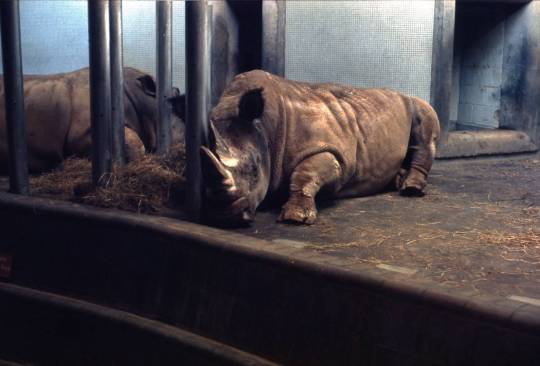
“Ben” the bull northern white rhinoceros (foreground) and his companion “Mashobeni” (background), a cow southern white rhinoceros, photographed by Laird Scott at the London Zoo in December, 1967. The pair lived together from 1964 to 1986, when both rhinos were transferred to other zoological facilities. [ x ]
#Northern white rhinoceros#Northern white rhino#FE#Southern white rhinoceros#Southern white rhino#EN#Mammal#Photo#Live specimen#Captive#Upload#Ben
72 notes
·
View notes
Text

BRUSSELS — Today, the Belgian Federal government’s Council of Ministers approved a legislative proposal for a ban on the import of hunting trophies of endangered animal species, put forth by Zakia Khattabi, Minister of Climate, the Environment, Sustainable Development and Green Deal.
The Minister’s preliminary draft bill follows the Federal Parliament of the Kingdom of Belgium’s unanimous vote in March 2022 in support of a resolution demanding that the government put the brakes on the issuance of trophy import permits for a broad array of threatened and endangered species.
This resolution protects species such as the hippopotamus, Southern white rhinoceros, African savannah elephant, lion, polar bear and argali sheep killed for sport.
The scope of the resolution also extends to all species listed in Annex A, along with certain species in Annex B of the European Regulation 338/97 on the protection of species of wild fauna and flora.
Member of Parliament Kris Verduyckt (Vooruit, Flemish Socialists), initiator of the legislative proposal to ban hunting trophy imports in 2020 and proposer of the aforementioned resolution, said:
“I am glad that this hard work is paying off. Minister Khattabi is now fully translating my proposal into a bill and the entire Council of Ministers approves it.
It’s time we really started protecting endangered species. Trophy hunters prefer to kill the largest and strongest animals, the loss of which contributes to the disruption and decline of animal populations.”
The European office of animal protection charity Humane Society International, a long-time vocal advocate against the import of endangered species’ trophies, lauded the government’s decision.
Ruud Tombrock, executive director for HSI/Europe said:
“We welcome the fact that the unanimous resolution of Parliament has been translated into a legislative measure and look forward to studying the details of the legislation once published.
Belgium is leading the way for other countries in Europe already listening to calls from their citizens to consign the import of hunting trophies to history.
The next step should be an EU-wide ban on the import of hunting trophies from endangered and protected species, again reflecting the views of citizens across member states in the European Union.”
Over the past 16 months, HSI/Europe has worked with MPs to ensure that the unanimous resolution of Parliament was translated into legislation.
Today’s approval is the culmination of this campaign.
MPs from different political parties have maintained pressure on Environment Minister Khattabi.
A recent response to a parliamentary question from MP Jan Briers (CD&V, Flemish Christian democrats) revealed that the Ministry had only stopped issuing permits for importing animal trophies since mid-March 2023, a delay which outraged many MPs.
This landmark decision by the Belgian government echoes the strongly held views of its people.
A 2020 survey by Ipsos commissioned by HSI/Europe showed that 91% of Belgians oppose trophy hunting and 88% support a prohibition on importing any kind of hunting trophy at all.
This sentiment is not limited to Belgium but is resonating across the European continent.
A 2023 pan-European poll conducted by Savanta in all 27 EU Member States on behalf of HSI/Europe laid bare the widespread public rejection of trophy hunting.
A striking 83% of respondents stood firm against this practice, with just 6% in favor.
The vast majority is expecting strong measures to be taken against trophy hunting, with a compelling majority (74%) rallying behind a national import ban and similar support for an EU-wide ban (73%).
These survey results underscore a profound and growing public concern across Europe, spotlighting the urgency and importance of wildlife conservation and the protection of threatened species.
Today, Belgium has echoed the urgent European call to action against trophy hunting, joining the ranks of countries like the Netherlands, France and Finland, which have each implemented various degrees of bans and restrictions on the practice of import of hunting trophies.
Momentum against trophy hunting is accelerating across the continent, with nations including the UK, Germany, Italy, and Poland now also involved in active discussions to impose bans at varying stages of progress.
Facts on trophy hunting:
• The Netherlands introduced a trophy hunting ban for more than 200 species in May 2016 on the Annex A of European Regulation 338/97, on the protection of species of wild fauna and flora by regulating trade therein, and of species in danger of extinction.
The import ban also applies to the following Annex B species: white rhinoceros, hippopotamus, African elephant, mouflon (wild sheep from the Caucasus), lion and polar bear.
A total of 200 animal species are affected by the import licenses ban.
• France implemented a ban on the import of lion-hunting trophies in 2015.
In 2023, a Bill proposal for registration aimed at “stopping the issuance of import permits for hunting trophies of certain endangered species was tabled.
•The import of hunting trophies into Finland is restricted since June 2023.
The new Nature Conservation Act includes a provision that prohibits the import of individual animals or their parts from the most endangered species worldwide, which are threatened by international trade as trophies from countries outside the EU.
• In the United Kingdom in March 2023, British lawmakers approved a ban on the import of animal hunting trophies covering 6,000 endangered species, which makes it one of the toughest in the world.
The legislation is now being debated in the House of Lords.
• In Germany, the Minister of the Environment, Steffi Lemke (The Greens), announced that she intends to restrict the import of hunting trophies from protected animal species.
Germany terminated the Country’s membership in the International Council for Game and Wildlife Conservation (CIC) in 2022.
• In Italy in 2022, a bill aimed at banning the import, export and re-export, to and from Italy, of hunting trophies obtained from animals that are protected by CITES, was presented.
After the fall of the government and the elections in 2023, the same bill was tabled again in parliament.
• In Poland, a bill sponsored by the deputy chairperson of the Sejm, the lower chamber of the parliament, reached committee stage discussion this month and is scheduled for further progress in August 2023.
• Trophy hunting of endangered species poses a severe threat to conservation efforts and the world’s natural heritage.
Trophy hunters prefer to kill the largest, strongest animals, whose loss causes declines in population.
The affected species, such as African elephants, lions, rhinoceros, and leopards, among others, are already facing the risk of extinction and play crucial roles in maintaining healthy ecosystems and biodiversity.
The loss of these iconic animals not only disrupts delicate ecological balances but also erodes cultural and historical significance.
Many species play important roles in their ecosystems. Their removal can have cascading effects on other wildlife, vegetation, and the overall health of the ecosystem.
• The EU is the second biggest importer of hunting trophies after the United States, as indicated in a report by Humane Society International/Europe from 2021, with an average of 3000 trophies imported in the period between 2014 and 2018.
• The top 10 species imported into the EU as trophies are:
Hartmann’s mountain zebra (Equus zebra hartmannae) (3.119), Chacma baboon (1.751), American black bear (Ursus americanus) (1.415), brown bear (1.056), the African elephant (952), African lion (Panthera leo) (889), African leopard (Panthera pardus) (839), hippopotamus (Hippopotamus amphibius) (794), caracal (Caracal caracal) (480), and red lechwe (Kobus leche) (415).
• The EU was the largest importer of cheetah (Acinonyx jubatus) trophies with 297 cheetah trophies imported into the EU during the study period.
• Belgium is the 13th largest hunting trophy importer of internationally protected species in Europe
• Shortly before the vote of the resolution last year, Animal Rights Belgium, another organisation campaigning against the import of hunting trophies in Belgium, delivered a petition with 37,000 signatures supporting the ban to the Federal Environment Minister, Zakia Khattabi.
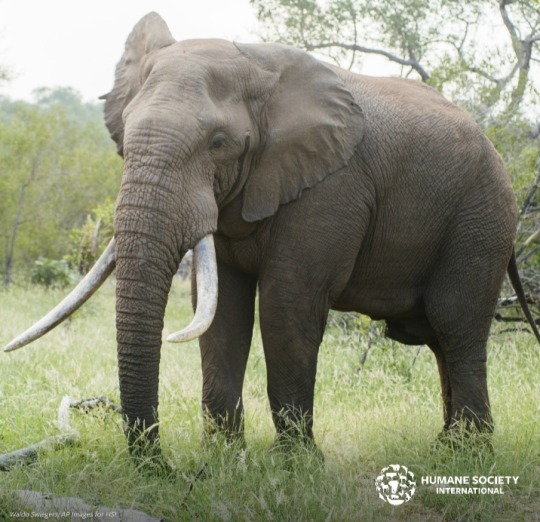
💛🙌💛
#Ban on Hunting Trophy#Protect Wildlife#Belgium#endangered animals#endangered species#European Regulation 338/97#Kris Verduyckt#Zakia Khattabi#Council of Ministers#Humane Society International#Ruud Tombrock#HSI/Europe#HSI#European Union#wildlife conservation#Nature Conservation Act#International Council for Game and Wildlife Conservation (CIC)#Animal Rights Belgium#save animals#animals#wildlife
11 notes
·
View notes
Text

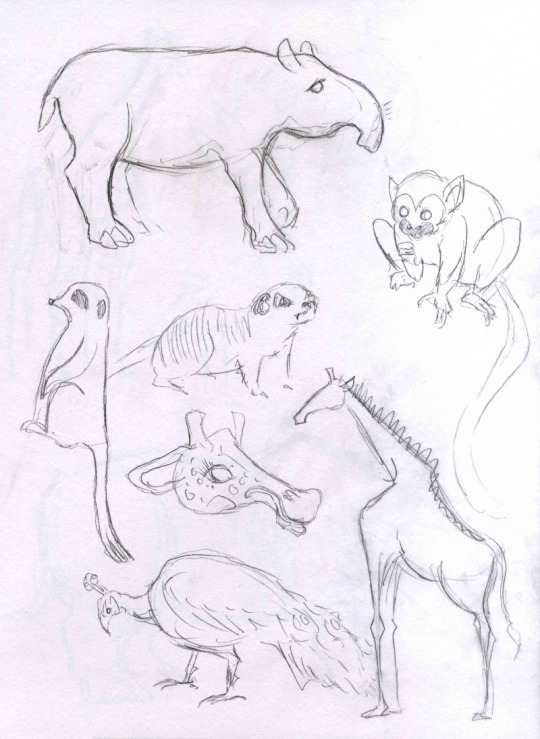
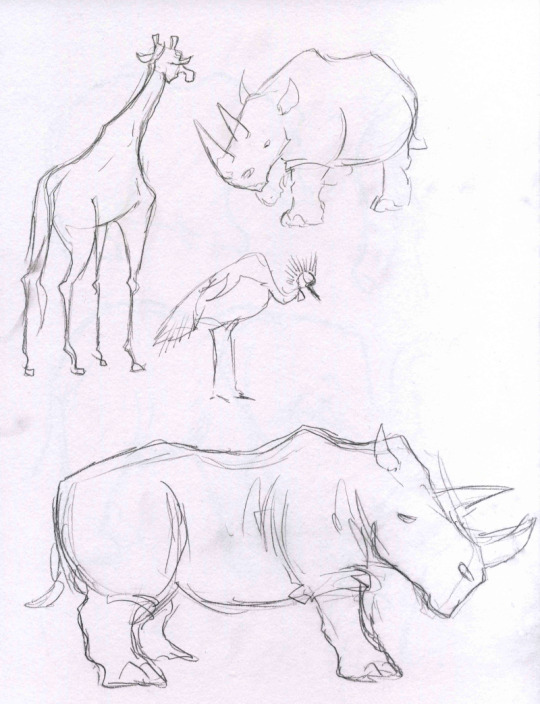



I don't think I ever shared these life-drawing sketches from the Reid Park Zoo? These are from November.
1. Chilean flamingo, rhea, giant anteater, capybara, crested screamer
2. Baird's tapir, squirrel monkey, meerkat, giraffe, peacock
3. Giraffe, southern white rhinoceros, East African crowned crane
4. Grizzly bear, African elephant
5. African elephant, Speke's gazelle, peacock, ostrich
6. Domestic goat, African spot-necked otter, lion, African wild dog, Aldabra tortoise
JoJo Seames, 2023
6 notes
·
View notes
Text
African rhino populations are rising for the first time in a decade
Published 22nd September 2023
Newly released figures show an increase in populations for critically endangered African rhino species, with the southern white rhinos' numbers increasing for the first time since 2012, however the Javan and Sumatran rhinos are reportedly still at the brink of extinction.
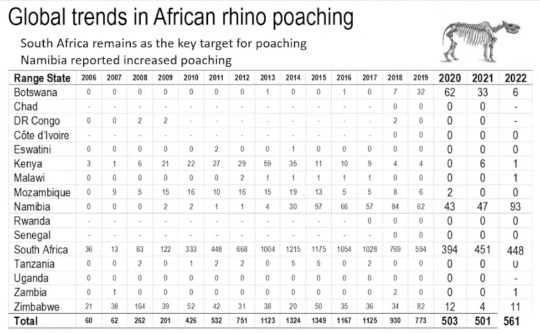
Reported poaching instances of rhinos in africa between 2006-2022
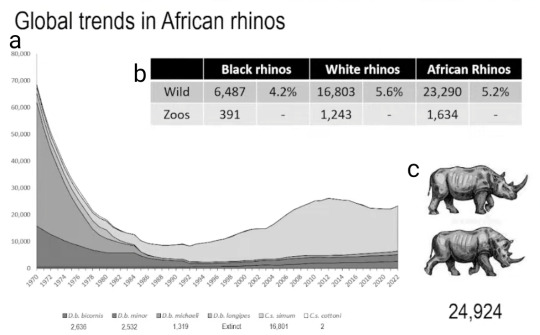
(a) African Rhino populations between 1970-2022, (b) wild and zoo African rhino populations in 2022 and their percentage increase between 2021-2022, (c) total wild and zoo African rhino populations

Sumatran rhino, image from
While white and black rhinos numbers are on the rise, 2 other rhino species, the Sumatran and Javan rhinos, remain dangerously threatened. Official reports estimate there are less than 80 or potentially around 30 individuals of Sumatran rhinos and 76 or possibly 64 Javan rhinos left in the world.
source:
2 notes
·
View notes
Photo

Southern white rhinoceros, Budapest Zoo
Fact from WWL: White rhinos have complex social structures. Groups of sometimes 14 rhinos may form, notably females with calves. Adult males defend territories of roughly one square mile, which they mark with vigorously scraped dung piles. The home range for adult females can be more than seven times larger, depending on habitat quality and population density. Breeding females are prevented from leaving a dominant male’s territory, which is marked and patrolled by its owner on a regular basis. Males competing for a female may engage in serious conflict, using their horns and massive size to inflict wounds.
6 notes
·
View notes